
Introduction to the Motion Vision Soundbar
I have always wanted to experience the MartinLogan planar speaker systems, but I lack the room size that is needed to really allow them to breathe. ML’s new Motion® series allows for a planar speaker that is designed to resemble a more conventional box speaker that shares some of that “ribbon sound” quality. The Vision delivers 5-channel surround sound from a soundbar that is both stylish yet unobtrusive, easy to install, and a snap to operate. The Vision incorporates three Folded Motion™ tweeters, four 4″ high-performance woofers, and seven amplifiers (one for each driver) to deliver 100 watts of total system power. When I first read about the Vision, I just knew that if ML was going to design and manufacture a soundbar, it would be something special.
MOTION VISION SOUNDBAR SPECIFICATIONS
- Design: Sound Bar for Placement under a Flat Panel HDTV, Ported
- Drivers: Three 1″x1.4″ Folded Motion Tweeters, Four 4″ Woofers
- Amplifiers: 7 x 15 Watts
- MFR: 43 Hz – 23 kHz, ± 3 dB
- Crossover Frequency: 3 kHz
- Inputs: 2 Optical (SPDIF), 1 Coaxial Digital, 1 R/L Analog
- Outputs: 1 Sub Out via Analog RCA, built in SWT-2 Wireless Transmitter for Select ML Subwoofers.
- Remote Control
- Dimensions: 5″ H x 39.9″ W x 5.85″ D
- Weight: 20.5 Pounds
- MSRP: $1499
- MartinLogan
- SECRETS Tags: SoundBar, Speakers, MartinLogan
Design and Set up of the Motion Vision Soundbar
It seems like soundbars are still proliferating since I last attended CEDIA in 2010. Almost every major speaker manufacturer has produced at least one model or another, and now, MartinLogan has developed the Motion Vision. ML has been well known by consumers for years by making wonderfully crafted electrostatic speakers that are made in the heartland of Kansas. Since their first speaker that was demoed at CES in 1984, the have now become firmly established as a loudspeaker ‘technology’ company (not just an ‘electrostatic’ company). The Motion series is designed like a more convention “box speaker” system with drivers that are typical in design except for the folded ribbon tweeter.

This tweeter design is not unique to ML, as it also appears in speakers like GoldenEar Technology, Emotiva and others. The biggest advantage to this type of tweeter is its ability to move air perpendicularly to the folded ridges of the diaphragm. Similar to how an accordion works, the diaphragm squeezes the air and requires almost 90% less excursion than the typical 1” dome tweeter.

The response time is increased while the distortion level decreases. The increased surface area also provides a wide, yet controlled sound dispersion to create a realistic, detailed sound stage. Included in the Vision are four 4” mid-woofers, along with three of the tweeters. Each driver has its own dedicated amplifier (for a total of 100 watts). All of these are housed in a very svelte looking piano black finished polycarbonate case with aluminum accents.
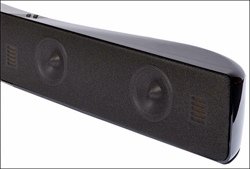
All the hardware needed for wall mounting is included and you have the option, like me, to place it on a counter top or hang it on a wall under your flat panel TV.
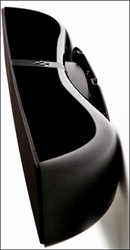
The speaker can be assigned for either type of installation. (By assigned, I mean the bass output will be modified from wall mount vs. surface mount). The overall appearance of the Vision complimented the gloss black of my 42” Samsung PDP nicely.
The back of the Vision has two vented ports, a stereo analog input, one sub output, one coaxial and two optical digital inputs. The Vision also has a SWT-2 wireless transmitter to connect to compatible sub. The small remote allows for volume adjustments as well as changing inputs, three discrete acoustic modes, “night” mode, and bass adjustments.
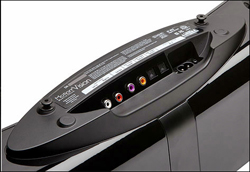
The Vision can emulate the sound of a 5.1 system, though like many “faux surround” systems, how much is a matter of listener’s preference. The Vision is not magnetically shielded, but this is less of an issue these days as CRT displays have gone the way of the Dodo. LCD and PDP screens are not affected by magnetic interference, so placing above or below your display is fine.
The instruction manual is very well written and gives detailed instructions for installing and operating the speaker. All of the different options for hooking it up are detailed as well. The top control panel allows for setting the volume and scrolling through the input modes. My only complaint about this product is the somewhat cumbersome sub menus you’ll need to access when setting up the Vision for the first time.

Notice my photo of the instruction manual called “An Overview of the Menu Structure”. I found that while I navigated the dense layers in the menu, if you hit the wrong button on the remote, you’d be thrown out to the very beginning and have to start wending your way through the menu again. I can’t tell you how many times I screwed up, but it was a lot. I became quite frustrated with it. (Unlike the ZVOX that I reviewed a few months ago, which was perhaps the easiest remote system I have ever used). In all fairness, when you finally do finish the setup, you will probably not need to dig down into the menu again to make substantial changes, but still…
The Motion Vision Soundbar In Use
Once the Vision was in place and setup on my table top beneath my PDP, I sat back and began my evaluation of the sound quality. Usually, a sound bar system has to make some compromises in sound due to the limited real estate inside the “box”. I’m glad to report that the Vision gives up very little in overall sound quality or output.

The treble was articulate, without being fatiguing. The mid range (perhaps the most important component because that is the range of the human voice) sounded firm, without excessive blooming. Male voices had weight and authority and the ladies sounded feminine; not like Barry White in heels. The bass had significant power which I had to tame a bit. I can not imagine the average listener needing a sub with this unit, but it’s nice to have the ability to add one. I have no doubt the excessive bass I was experiencing was from a near corner placement of the Vision in my room and after some decreasing, I found a spot where the bass was tight, but still punchy. This is where selecting “wall mount” vs. “shelf mount” comes in handy for tailoring the bass to suit your personal taste.
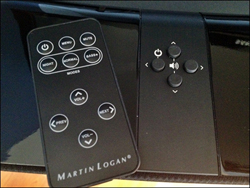
My wife immediately noticed a sound quality difference from the afore mentioned ZVOX that she had been listening to (and enjoying up to this point, I might add). We were both pleasantly astonished at how well the overall sound from the Vision filled the room, even at low volume. When the volume was cranked, it only sounded better with more authority and musicality.

If I had not known better, I would have guessed the sound was coming from a nice quality pair of bookshelf speakers. It was a pleasure to watch movies over the Vision, but music listening was also very enjoyable, too.
Of movies and dialog: I had a few movies available for review that I tested on the Vision. The Raid: Redemption was an Asian film that had dubbed English and a plot that involved a SWAT team going through a high rise, floor by floor, with the residence all out to kill them. Hand-to-hand combat, guns, knives and grenades were presented with clarity and deep, thudding impact. Voices remained distinct, even when the action started to get way over the top.

Shell casings had a distinct “tinkle” as they rattled onto the floor.

Punches to face actually made me wince due to their realistic sound that the Vision easily reproduced. Zoinks! My wife and I sat and watched Downton Abbey via Hulu, and the dialog (there is plenty of that) was always clear and precise. Let’s face it: If the sound bar you have does not reproduce human dialog in a convincing manner, then you have not invested your hard earned dollars wisely.

Even though the Vision has seven different drivers, they all blended seamlessly into a wide soundstage that did not seem too exaggerated or pinched. It all just sounded “right”. I expected nothing less from a speaker made by Martin Logan.
Of music and dancing: I was equally satisfied with the Vision when I used it to play music. Bridge Over Troubled Water: by Simon and Garfunkle, perhaps the most harmonious rock/ballad duo of all time, allowed me to evaluate the sound of acoustical instruments as well as to distinct voices side by side.
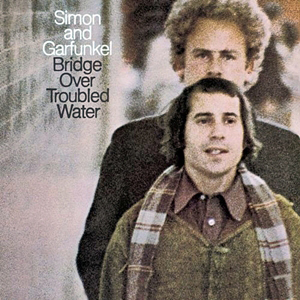
Simon dominated the center on most of these tracks, but Artie’s angelic tenor blended smoothly and complimented his partner. Instruments had both depth and width on the soundstage and none of the music seemed cramped coming from a sound bar. A favorite instrument of mine is the pipe organ. This is always a “go to” instrument when I evaluate the mettle of a speaker.
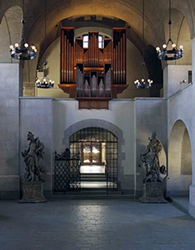
Mozart called the organ the “King of Instruments” due to its ability to become an orchestra in the hands of a single virtuoso. The frequency range of a typical organ can be quite large. My test was to sit quietly and listen to some recordings that I have listened to since my college days. E. Powers Biggs playing Bach on the Flentrop organ at the Germanic Museum in Harvard provided a fine test. The acoustics of the venue allow for a 5 second decay at the end of each note, and the classic voicing of the pipes (un-nicked) provided a very distinct and fine overall tonal quality of the tracker action organ.
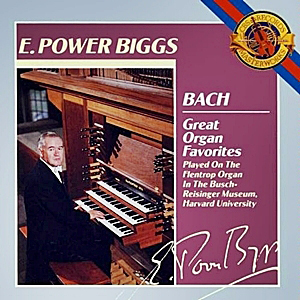
The Vision gave the organ “air” and the pedal notes were strong and tight. The distinctive sound I had grown up on was all there. If the Vision was not a sound bar designed to hang under a TV, I would have considered it just for music reproduction alone. I guess I should listen to the Motion 20s or 40s, which are the towers in the Motion series. (Mental note: audition the Motion 40s, ASAP). In anycase, the sound quality speaks well for the whole Motion series design.
Conclusions about the Motion Vision Soundbar
I admit that I have not listened to every sound bar out there to compare with the Motion Vision. However, I have listened to dozens of bookshelf and tower speakers and can say the Motion Vision provided deep, rich sound comparable to some of the best bookshelf speakers I have had the pleasure to audition. Sure, the sound quality was overall superior to my ZVOX, but at nearly 3 times the price, it should be superior. The Motion Vision is sleek, stylish and well engineered. It provided a very enjoyable experience when watching movies or TV shows. It also started a party every time I played music through it. Other than an overly cumbersome menu structure with the remote, I found little to fault and a lot to like about this product. If you are in the market for a new sound bar and sound/style are high on you list of priorities, I recommend that you envision this one!


